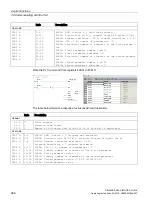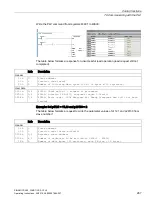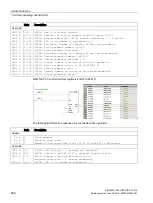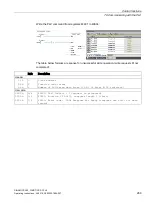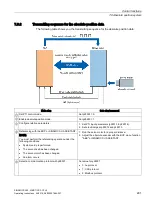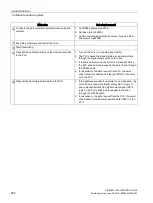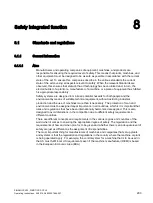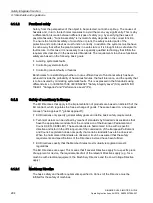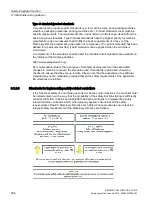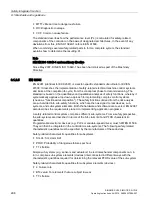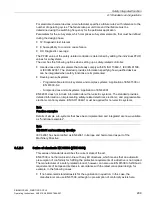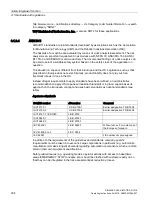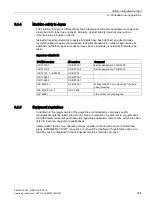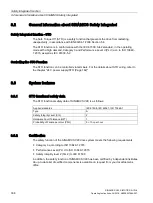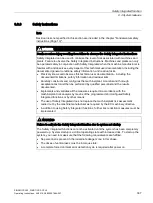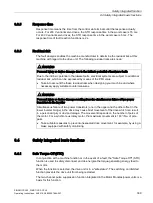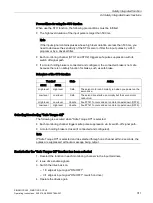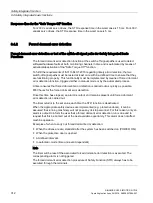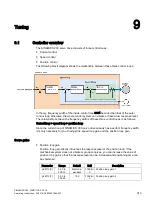
Safety Integrated function
8.1 Standards and regulations
SINAMICS V90, SIMOTICS S-1FL6
300
Operating Instructions, 04/2019, A5E36037884-007
●
A harmonized European standard (e.g. EN 62061, EN ISO 13849, EN 60204-1)
references EN 61508. This ensures that the appropriate requirements of the directives
are fulfilled ("standard that is also applicable"). When manufacturers apply EN 61508
properly and responsibly in accordance with this reference, they can use the presumption
of conformity of the referencing standard.
EN 61508 covers all the aspects that must be taken into account when E/E/PES systems
(electrical, electronic, and programmable electronic System) are used in order to execute
safety functions and/or to ensure the appropriate level of functional safety. Other hazards
(e.g. electric shock) are, as in EN ISO 13849, not part of the standard.
EN 61508 has recently been declared the "International Basic Safety Publication", which
makes it a framework for other, sector-specific standards (e.g. EN 62061). As a result, this
standard is now accepted worldwide, particularly in North America and in the automotive
industry. Today, many regulatory bodies already stipulate it (e.g. as a basis for NRTL listing).
Another recent development with respect to EN 61508 is its system approach, which extends
the technical requirements to include the entire safety installation from the sensor to the
actuator, the quantification of the probability of hazardous failure due to random hardware
failures, and the creation of documentation covering all phases of the safety-related lifecycle
of the E/E/PES.
8.1.2.7
Risk analysis/assessment
Risks are intrinsic in machines due to their design and functionality. For this reason, the
Machinery Directive requires that a risk assessment be performed for each machine and, if
necessary, the level of risk reduced until the residual risk is less than the tolerable risk. To
assess these risks, the following standards must be applied:
EN ISO 12100-1 "Safety of Machinery - basic terminology, general principles for design"
EN ISO 13849-1 "Safety-related parts of control systems"
EN ISO 12100-1 focuses on the risks to be analyzed and the design principles for minimizing
risk.
The risk assessment is a procedure that allows hazards resulting from machines to be
systematically investigated. Where necessary, the risk assessment is followed by a risk
reduction procedure. When the procedure is repeated, this is known as an iterative process.
This can help eliminate hazards (as far as this is possible) and can act as a basis for
implementing suitable protective measures.
The risk assessment involves the following:
●
Risk analysis
–
Determines the limits of the machine (EN ISO 12100-1)
–
Identification of the hazards (EN ISO 12100-114)
–
Estimating the level of risk (EN 1050 Paragraph 7)
●
Risk evaluation
As part of the iterative process to achieve the required level of safety, a risk assessment is
carried out after the risk estimation. A decision must be made here as to whether the
residual risk needs to be reduced. If the risk is to be further reduced, suitable protective
measures must be selected and applied. The risk assessment must then be repeated.
Содержание SIMOTICS S-1FL6
Страница 1: ...SINAMICS V90 SIMOTICS S 1FL6 ...
Страница 2: ......
Страница 87: ...Mounting 3 1 Mounting the drive SINAMICS V90 SIMOTICS S 1FL6 Operating Instructions 04 2019 A5E36037884 007 85 ...
Страница 89: ...Mounting 3 1 Mounting the drive SINAMICS V90 SIMOTICS S 1FL6 Operating Instructions 04 2019 A5E36037884 007 87 ...
Страница 342: ...Tuning 9 9 PI P switching SINAMICS V90 SIMOTICS S 1FL6 340 Operating Instructions 04 2019 A5E36037884 007 ...
Страница 384: ...Parameters 10 2 Parameter list SINAMICS V90 SIMOTICS S 1FL6 382 Operating Instructions 04 2019 A5E36037884 007 ...
Страница 432: ......

